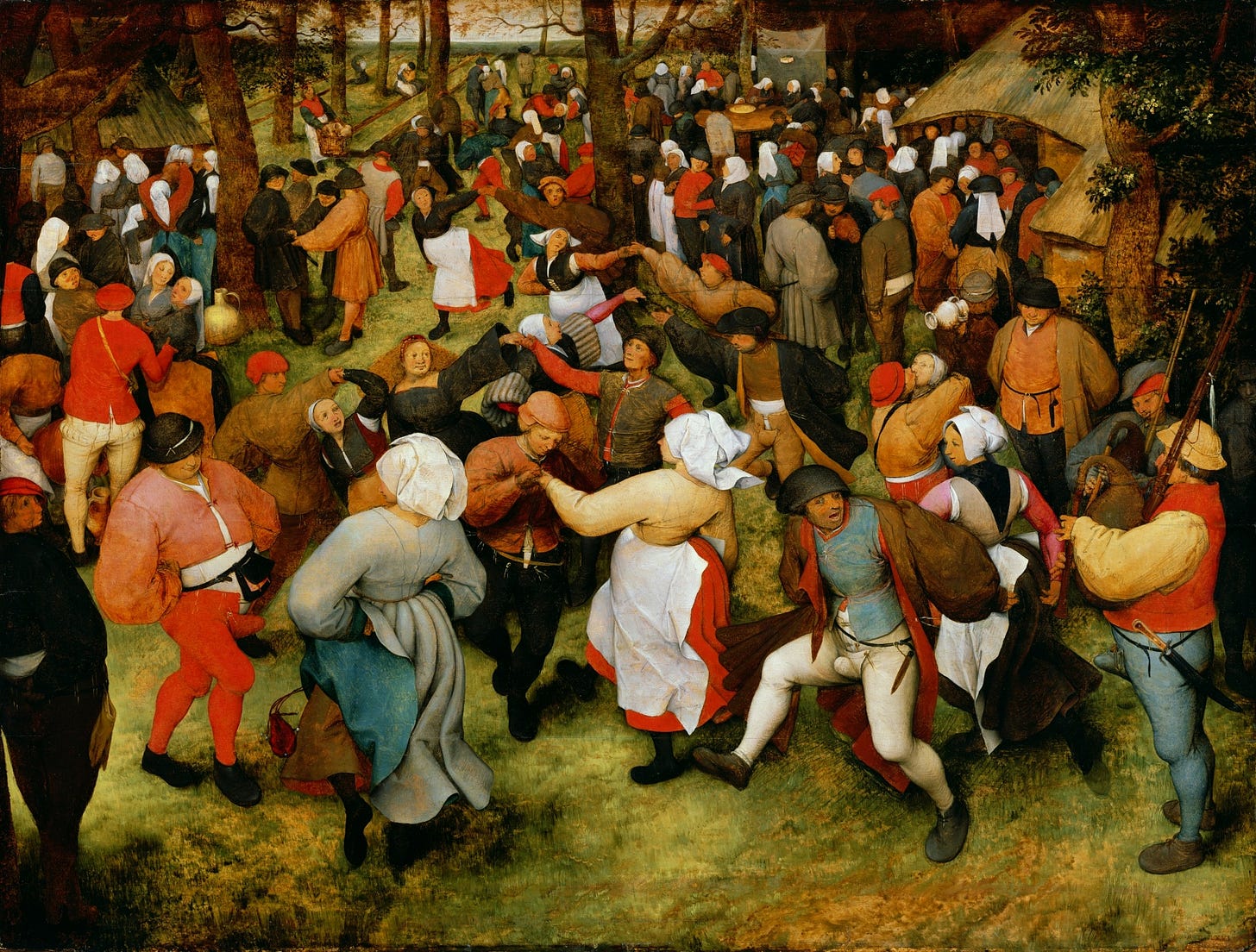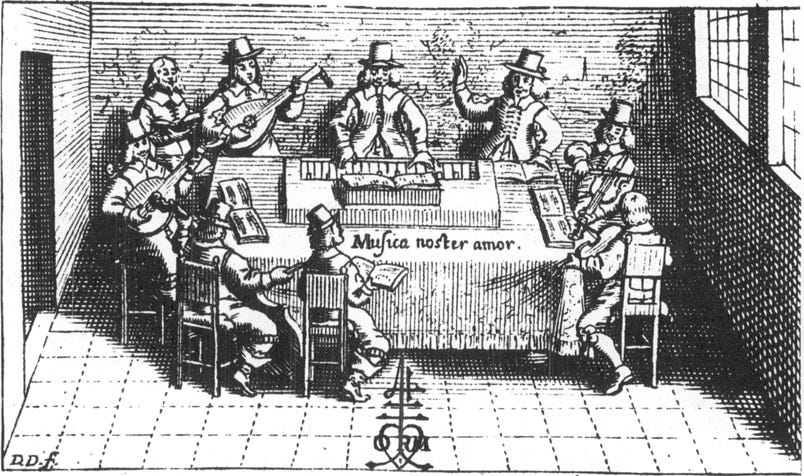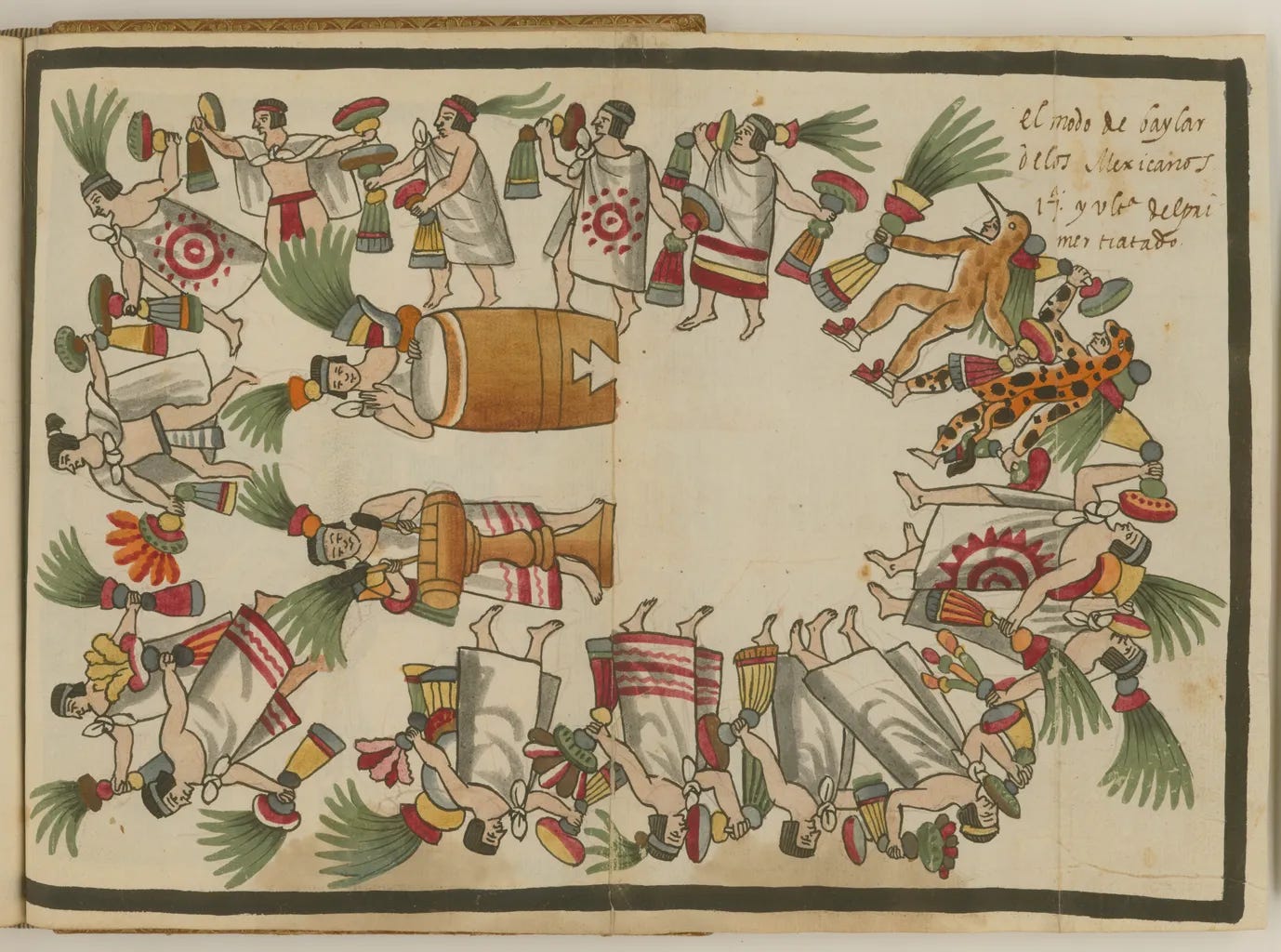Classical Music Got Invented with a Hard Kick from a Peasant's Foot
Or why we need less math in music theory
The very first things you see on a page of music are the time signature and metronome markings—those numbers that literally set the pace for the performance. They make the whole process seem mathematical and precise, but—as I’ll show—nothing could be more misleading.
Let me start with a simple question: Why do we have time signatures in the first place?
If you want to support my work, take out a premium subscription (just $6 per month).
Sure, they indicate the rhythmic pattern of the music, but why does rhythm need a pattern? It isn’t hard to imagine a music without meter, and the more you think about it, the more peculiar the time signature seems.
Is there any reason why music should be constrained by an unyielding pattern? Why should these musical handcuffs repeat bar after bar in a composition?
Imagine if every sentence in a story were expected to contain the same number of alphanumeric characters. That would be absurd, no? Each sentence should have its own organic length, unconnected to what came before or goes after.
So why doesn’t our music do that?
“The music of Mozart moves to the beat of the peasants’ feet.”
Here it’s worth remembering that some stories do have repeated patterns of syllables—especially our oldest and most cherished narratives. In ancient times, the most admired stories were always set to a meter.
But over the course of centuries this became more an exception than a rule. Today almost every story is told without meter—except tales for children, who are engaged by the hypnotic pattern of rhymes and stressed syllables.
Music, for some reason, went in the opposite direction.
Meter wasn’t specified for songs until around the year 1200. And we shouldn’t be surprised that, when medieval theorists began to explore the concept of musical meter, they drew on analogies from poetry. Poems also have meter, and although it isn’t quite metronomic, this still provided a useful role model for other rhythmic arts.
But musicians inevitably needed a way of conceptualizing meter that was better suited for their own vocation. And when they pursued that goal, the end result may have looked like a kind of mathematics—certainly the time signatures and metronome markings suggest as much—but in reality, their approach to rhythm was always rooted in the human body.
This is important, so I want to emphasize it. Musical meter is due to human anatomy—and has nothing to do with math.
And that’s still true today, even though we don’t often think of musical notation as embodied.
Our current-day time signatures and bar lines originated in a system called mensural notation. Once again, the very name seems to indicate a kind of scientific or mathematical approach to the subject.
After all, mensural means “related to measurement.” But even here, the beat (or tactus, as it was called) was conceptualized as an extension of the human body.
Commentaries from the sixteenth and seventeenth century actually describe the tactus as a bodily pulse. It’s like your heartbeat. But in practice, the human hand was viewed as the repository of this rhythm.
Duple meters were described in terms of an up-and-down movement of the hand. Triple meters posed a tougher problem—but it was solved by assigning two beats to the down-stroke of the hand, and one for the up-stroke.
Four beats were measured by subdividing the two-beat movement. According to a 1627 treatise: “The first part is lowering the hand, the second is the stop at the bottom of the gesture, the third is raising the hand….and the fourth is the stop at the top of the gesture.”
“The entire evolution of music is a battle over whether rhythm will be driven by the hands or the feet. The brain, I’m sorry to say, exerts no control over this process.”
In the face of every musical challenge, the human body resolves the issue, not a mathematical formula. So instructional texts of that era addressed a range of questions related to hand movement:
Does the beat begin when the hand starts to move—or when it reaches the end point of the stroke?
When the hand reaches the final note, does the music stop with the stroke, or do the tones continue after the movement ends?
How do you subdivide beats while the hand is in motion?
Etc. etc.
The mensural system was eventually replaced by our modern time signatures, metronome markings, and bar lines. Yet even today, orchestral music in performance is literally “conducted” by the human hand.
But this is only half of the story.
The human hand had a rival in its quest for dominance over musical rhythm—namely, the feet. This conflict is never discussed in music history books, but we might say that highbrow music was driven by the (conductor’s) hand and lowbrow music is propelled by the (dancers’) feet.
In other words, the entire evolution of music is a battle over whether rhythm will be driven by the hands or the feet.
The brain, I’m sorry to say, exerts no control over this process—although fingers and hips also make their occasional claims.
Only at a very late stage, does the human brain assert its prerogatives, attempting to impose analytical frameworks on the beat. But it never really takes charge. That’s true even in the current era—despite the illusion of disembodied rhythm conveyed by software or algorithms or AI.
If we really relied upon counting the beat, rhythms would be in groups of five or ten, much like our standard numerical system—initially a translation of finger-counting into more flexible mathematical systems. But Western music instead showed its primary allegiance to the feet.
That’s why music always gravitates to duple or triple systems—and eventually embraces the four-measure phrase which, in the words of musicologist Charles Rosen, became increasingly popular and finally gained “its stranglehold on rhythmic structure” around 1820.
Even today—two centuries later!—music is primarily organized in four bar phrases. This is true for almost every genre.
Why did this happen?
Rosen mentions in passing that the “periodic phrase is related to the dance.” And dancers demand “a phrase pattern that corresponds to the steps and the groupings” of their movements.
He offers this opinion as though it is obvious and perfectly reasonable. Yet the notion that the symphony or string quartet should be shaped by the needs of dancers is absolutely bizarre—these are precisely the musical forms that we would expect to resist the beat of human feet.
The symphony is music created by human intelligence for brain stimulation—at least that’s what thinker Steven Pinker tells us. So why are we worried about dancers?
The fact that dancing not only influences the rhythms of the classical style but actually dominates its phrasing and structure is revealing. It tells you how powerful the human body is in our musical aesthetics.
So you should be distrustful when the ‘experts’—professors or philosophers or critics—tell you the that musical aesthetics is all about beauty or symmetry or some other abstract notion.
It’s actually determined by brute physicality.
That’s why I talk so much about embodied aesthetics. Our theories of music need to be grounded in the realities of our bodies—or they will lack all explanatory power. And, most surprising of all, this isn’t just true of disco or salsa or reggae or other dance music styles, but even the great masters of symphonic music.
In a very real sense, the music of Mozart moves to the beat of the peasants’ feet.
Let’s take another example, namely the music of Bach. In the world of classical music, Bach is considered the most cerebral and intellectual of composers—and certainly not a purveyor of dance music.
Yet “hundreds of titled dances by Bach have been preserved,” writes musicologists Meredith Little and Natalie Jenne, “and many more have undoubtedly been lost.”
They note that “Bach devoted a significant portion of his life to the composition of dance music,” yet until they published their book Dance and the Music of Bach, no scholar had deemed this topic worthy of a book-length study—“nothing which shows the choreographic origins of his dance forms, and no studies tying Bach’s dances to those of his predecessors and contemporaries.”
Even stranger, they tell us that “there is no satisfactory history of Baroque dance music.” That’s a bizarre omission in genre where so many works bear names such as gavotte, minuet, gigue, sarabande, and other dances.
It’s clear from surviving compositions and documents, that Bach had a deep grasp of dance styles, even those popular in other countries. Then again, at least three of his friends were French dancing masters.
That shouldn’t surprise us. Parisian dance instructors were in high demand among German courts, and even members of the middle class participated in the craze. And where there’s an obsessive interest in dance, music is also in demand. So any account of the Baroque era that ignores or glosses over this fact, presents a very misleading view of music history.
RELATED ESSAYS FROM THE HONEST BROKER:
But if there’s hardly any serious interest in Bach’s connection with dance, there’s an abundance of research into the mathematical aspects of his work. Gödel, Escher, Bach by Douglas Hofstadter even won a Pulitzer Prize.
But is Bach really a math-driven composer? Or did the beats stamped out by dancer’s feet have more impact on his music than counting on fingers?
If you consult Google about this matter, the answer comes back immediately. Bach turned math into classical music.
In contrast, when you do a search for danceable musicians, you are referred to Madonna, Sister Sledge, the Village People, and Gloria Gaynor.
Such is the divide in our musical culture, even more immovable than the separation between highbrow and lowbrow, or commercial and artistic. The more serious your aims in music, so goes the conventional wisdom, the less you care about dancers.
Yet consider the number of formal terms in music that originally derived from dancing. Many musicians use the term waltz as a generic way of referring to compositions in ¾ time, but here too the time signature is secondary—the waltz originally referred to the movement of dancers.
The name derives from the German word walzen, signifying a rolling or rotating movement. And that, of course, reminds us of rock ‘n’ roll, another term that is now used as the name of a music genre, but obviously began as a description of body movements on the dance floor. The same is allegedly true of the hop in hip-hop, and the swing in swing jazz.
Classical music may require the audience to stay seated (and please turn off your phones), but that doesn't mean that its terminology is any less rooted in body movements. That’s true of the minuet, gavotte, polonaise, mazurka, bolero, sarabande, pavane, allemande, and a bunch of other compositions that now flourish in the concert hall, not the dance floor.
I’m not sure I would go so far as Ezra Pound, who once claimed “music begins to atrophy when it departs too far from the dance.” But he isn’t wrong to see the rhythmic movements of participants as a sign of vitality and energy in a musical genre or idiom.
And it isn’t just the feet of dancers that set the pace for Western music. The feet of soldiers have been almost as influential. Scholar William McNeill explores this in his insightful book Keeping Together in Time, where he explains that many of his key insights into music came after getting drafted to serve in World War II, and finding himself forced to participate in drill marching.
He thought he would hate this senseless movement, but found instead it “somehow felt good.” His later research showed that others had felt the same over the centuries, and that organized movement played a larger role in human culture than most of us realize—especially in an age when people consume music while plugged into electronic devices, and not while in active movement with its rhythm.
These considerations explain why my views on music aesthetics have deviated so widely from the current consensus—especially in recent years when more research on the physiological impact of rhythm and music has been published. I now believe that any approach to musical aesthetics that doesn’t give full and close attention to its embodied qualities is deeply mistaken.
This has implications for many subjects—and I can’t even begin to address them here. But just consider the obstacles faced by AI when it attempts to control the musical arts, if in fact these are intimately built on the brute reality of having a physical body.
Or what about the impact of streaming platforms on our musical culture, if they treat songs as intangible, little more than data? Or what should we think of the postwar shift in jazz culture away from entertainment for dancers, as it sought legitimacy as a highbrow genre to be consumed while seated (eerily mimicking the same shift that classical music pursued with such zeal—and caused its rupture with the mass audience)?
Just consider this chart of genre popularity in the United States, and consider what happened to jazz when the dance halls closed during the 1950s.

Everything else might change in music, but the dominant genre always pleases the feet.
Even our understanding of animal behavior is enriched by a grasp of embodied rhythms. You can detect rhythmic activities everywhere in the natural world, many of them obviously linked to survival traits. And by studying these phenomena in other species, we gain many insights into our own.
These are subjects that I hope to return to another day. But the big picture should already be clear to you. The rhythmic drive in music—of every genre—cannot be reduced to a time signature or mathematical formula.
It’s driven by the hands and feet of the audience—and that’s just as true for Bach and Mozart as for the Afro-Cuban music of Havana or the ecstatic raves of EDM fans. This perspective helps us understand tango and disco, but also Beethoven and Haydn.
By accepting this—even better, by celebrating this—we not only gain a better understanding of the history and essence of our music, but perhaps a firmer sense of what we ought to do to ensure its healthy future.







Great article Ted, for sure many important viewpoints that deserve to be kept at the core of understanding rhythm and pulse -- but I would like to propose, as I often do with your takes, that this does not go quite far enough.
"Embodied" means what? A somatic and consciously cultivated connection to one's own body and its relations to others' bodies. Okay I just made that up, but it gets me to my point: sure lots of dance has roots in group rituals -- and some of these have to do with being mounted by spirits, yet another direction to go, but a lot of it, and certainly many 20th century forms has much more to do with sex.
It's all about sex.
Sex is whats left out of these conversations, not feet.
It's not hands v. feet v. brain & math -- it's disembodied brains in jars versus sweaty mammals that physically and gloriously copulate and procreate.
The OG Kokopelli has a huge erection. Where did that go? He's been castrated by our body-shaming, sex-perverting twisted "Judeo-Christian" mores. That's my speculation anyways. Fertility gods and goddesses need swollen bellies and/or swollen members, that's obvious.
Also, you said: "rock ‘n’ roll, another term that is now used as the name of a music genre, but obviously began as a description of body movements on the dance floor."
Um: not really, right? Again these are euphemisms for good old coitus.
"Roll with me Henry" Etta James' answer song to "Work with me Annie" wasn't about just dancing otherwise they wouldn't have RE-titled it "Wallflower" for release, that's some sterilizationing at work, just like with Kokopelli.
So yes, until we take it back to the mystical union of the primoridal practice of fucking, I don't believe we have yet cracked the cork on the deeper conversation about rhythm. But: it is a good start to get some distance from math as a derivation rather than simply a mode to just keep track of what's happening, which is how I see it.
YES! Bach is *the perfect* composer to illustrate your point. It is indeed astonishing that only one book about his many musical dance forms has yet been written. I am similarly surprised to know how little research has been done on Baroque dance forms in general.
Two further classical anecdotes come to mind:
1) Lully, a French baroque composer and dance master who famously died of gangrene after stabbing his own foot with the emphatic downward movement of his time-keeping stick. The beat reigned supreme, and he quite literally paid for it with his life… !
2) the riots after Stravinsky’s Rite of Spring — which was, after all, a ballet. My small children are most captivated by ballet music (Firebird, Nutcracker, etc). I think instinctively they feel the natural rhythms and patterns more keenly than in musical forms more removed from dance.
Love your work, Ted. Always nice to see what you are reading, thinking, and doing. Hi from Los Angeles!